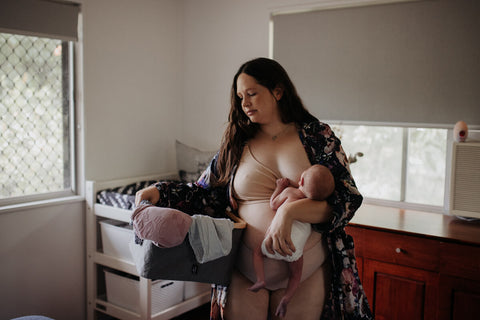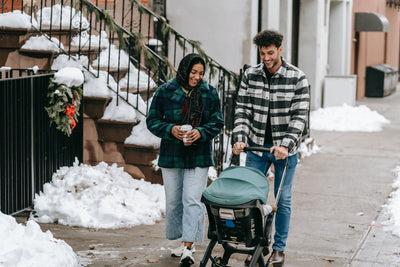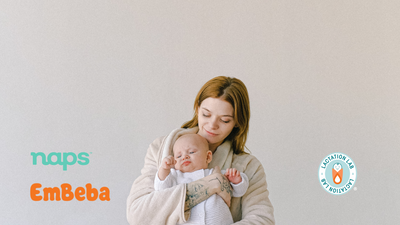Nursing Bras 101: What You Need to Know
Nursing Bras 101: What You Need to Know
by Katie from cake maternity
If you're an expecting mother or a new mom, one essential item you'll need to add to your wardrobe is a nursing bra. Similar to shopping for your first training bra, finding the right nursing bra can be overwhelming and confusing. As your breasts will be changing and fluctuating during this time, it's crucial to understand what to look for in a nursing bra to ensure comfort, support, and convenience. That's why we've created our "Nursing Bras 101" to guide you through the process and make it a little less daunting. In this post, we'll cover everything from when to buy a nursing bra to the features you should look for, so you can confidently choose the best nursing bra for you.
What is a nursing bra?
To put it simply, a nursing bra is any bra that facilitates breastfeeding. This will either be through the addition of a drop down or pull aside cup which allows you to expose your breast.
What makes a good nursing bra?
The difference between an average nursing bra and a good nursing bra is how well it caters to the physical changes your body can undergo during pregnancy and postpartum, while providing comfort and support.
Changes that can occur:
- Rapid fluctuations: Don’t expect your size to only change when your milk comes in! One of the first signs a woman is pregnant is often rapid breast growth during the first few weeks.
- Tenderness: As your hormones surge and your size changes, you can pretty much guarantee there’ll be some accompanying tenderness. This can feel similar to the days leading up to your period, but often hangs around longer than a few days.
- Milk duct development: This happens much earlier than you would expect, with ducts starting to develop as early as the first trimester.
- Nipple sensitivity: To get prepared for breastfeeding the nerve endings will have a higher amount of blood flow to them and will be more sensitive as a result.
- Higher temperature: Your body temperature increases during pregnancy, and even more so when your breasts are developing glandular tissue and cells. This process uses energy, which in turn produces heat.
What to look out for:
A good nursing bra will accommodate all of the above by being comfortable, durable, breathable, and supportive, all while growing with you. Look out for a bra which will fit you when you’re at your emptiest and remain comfortable when you’re at your fullest.
Features to look out for:
- Moulded cups to accommodate your growth.
- A breathable cotton lining to help with your increase in temperature.
- Wider straps to evenly distribute the weight of your heavier breasts.
- Durable clips which hold up after numerous feeding sessions.
- 6 rows of hooks and eyes to accommodate the increase and decrease of your ribcage, thus extending the life of your bra.
- Cotton folded edge sling to support you and hold your breast in shape while nursing. These may be side slings or A-frame slings.

What kind of nursing bras are there?
There are essentially three kinds of nursing bras, each of which accommodate different stages of pregnancy and breastfeeding.
- Multi-Fit
These styles follow XS-XL sizing and fit approximately 3-4 different cup sizes and 1.5 different band sizes per size. This is extremely helpful when it feels like your breast size is changing by the hour.
- Cup Sized
This includes any style which goes by individual cup and band sizes, e.g. 32D, 34G, 38C and so on, and includes both wire-free and flexi-wire styles. Since they are designed specifically to fit that size they can provide more support than their multi-fit counterparts, but they should only be worn during periods of less size fluctuation to minimize any chance of restriction.
- Seamless
These are exactly as they sound, no seams and super comfortable. This makes them the perfect option for any stage during your pregnancy and breastfeeding journey, particularly those times when it feels like your size is all over the place.
Which kind of bra, when?
Now for the nitty gritty and what you probably came here to find out, which type of bra should be worn during each stage of development?
Trimester 1
During the first few months of pregnancy everything is super sensitive and tender, as this is when the most amount of growth occurs before your milk comes in postpartum. We recommend mamas stick to a seamless or multi-fit bra during this stage to ensure you’re comfortable while still supporting your precious milk ducts during the earliest stages of their development.
Trimesters 2 & 3
While your cup size tends to stabilize during this time, you’ll experience an increase in your band size as your rib cage expands to accommodate your growing bub. During this stage you can wear any kind of nursing bra you like, as long as it has 6 rows of hooks and eyes so that you can continue to let it out as your rib cage expands. This way you’ll be able to continue wearing the same bra for longer, rather than buying a new one every time your size changes.
Trimester 4
So your beautiful bub is in your arms, it’s all smooth sailing from here right? Well it’s time to prepare for a significant increase in your cup size as your milk comes in. Your breasts can increase up to 5 cup sizes in a matter of two days, so it’s essential to stick to seamless styles which will grow with you.
6-8 Weeks Postpartum
By this time your milk flow should have regulated, which means you’ll have a pretty good idea of what size you’ll be for the rest of your breastfeeding journey. From now on you’re free to wear any kind of bra again, just make sure they’re fitted properly to reduce the risk of clogged ducts.

How to choose a nursing bra:
When selecting nursing bras, it is important to consider factors such as size, style, and purpose. Just as with pre-pregnancy bras, you may choose a nursing bra based on what you plan to wear it with, whether it be a t-shirt, active wear, or work attire. Nursing bras are available for a variety of purposes, such as pumping, nursing, sleeping, working out, or going to work.
It is recommended that you have at least three nursing bras on hand - one in the drawer, one being worn, and one in the wash. If you are a new mother and are still getting organized, it may be helpful to have additional bras as backups.
As you will likely be nursing throughout the night, it is important to have a comfortable sleeping bra or a nursing bra that doubles as a sleeping bra. There are many options available to suit your size, lifestyle, and style preferences. While your size may be changing, your personal style and color preferences are likely to remain consistent. Rest assured that there is a nursing bra out there to meet your needs.
Note: The views expressed in this article belong to the author.

About the author:
Katie is the proud mum of two beautiful girls and has been responsible for all the designs, style and fit at Cake Maternity for over a decade now.
Katie is a nursing bra specialist and a fit, pattern and grading technician. She is passionate about breastfeeding and the many benefits it offers to both mum, baby, and the environment.
She is determined to make the breastfeeding journey a comfortable, supportive, and beautiful one for all mums, understanding that it doesn’t always come easy to everyone. That’s why she has made it her mission to empower women as they mindfully navigate the world of motherhood and help make breastfeeding easier, through experience-driven innovation.






